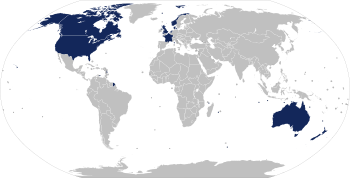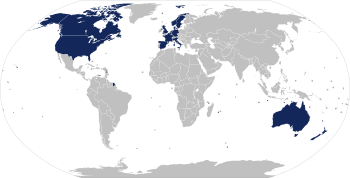Five Eyes facts for kids
Quick facts for kids
Five Eyes
|
|
|---|---|

Contributors shown in blue
|
|
| Working language | English |
| Type | Intelligence alliance |
| Contributors | |
| Establishment | |
| 14 August 1941 | |
|
• BRUSA Agreement
|
17 May 1943 |
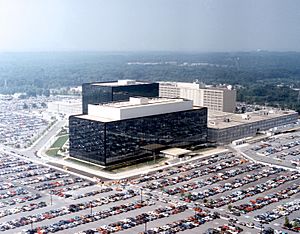
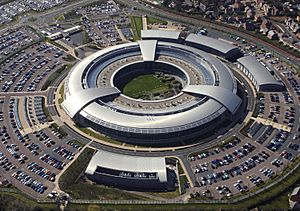
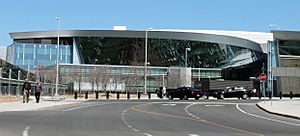
The Five Eyes (FVEY) is a special group of five countries that share secret information. These countries are Australia, Canada, New Zealand, the United Kingdom, and the United States. They work together to understand what's happening around the world. This group is based on a secret agreement called the UKUSA Agreement. It helps them cooperate in gathering and sharing "signals intelligence." This means they listen to and analyze electronic communications.
The idea for the Five Eyes started during World War II. British and American code-breakers began meeting secretly. This was even before the US officially joined the war. Later, in 1941, the Allies signed the Atlantic Charter. This document set out their goals for the world after the war.
After World War II, the world entered the Cold War. This was a long period of tension between the Soviet Union and Western countries. The Five Eyes alliance became more formal during this time. They developed a system called ECHELON. This system helped them listen to communications from the former Soviet Union and its allies. Today, it is used to monitor communications worldwide.
In the late 1990s, people found out about ECHELON. This caused a big discussion, especially in Europe. Later, during the "war on terror," the Five Eyes expanded their ability to watch communications. They focused a lot on the World Wide Web. In 2013, a former NSA worker named Edward Snowden shared secret documents. These documents showed that the Five Eyes countries were sometimes watching their own citizens. They also shared this information with each other. The countries say this was done legally.
Even with some disagreements, the Five Eyes group is one of the biggest intelligence alliances ever. They share many types of secret information. This includes not just signals intelligence (listening to communications). It also includes military information, human intelligence (from spies), and geospatial intelligence (from maps and images).
Contents
Who is in the Five Eyes?
This table shows the main government agencies that are part of the Five Eyes alliance in each country. They all work together to share important information.
| Country | Agency | Abbr. | Role |
|---|---|---|---|
| Australian Secret Intelligence Service | ASIS | Human intelligence (spies) | |
| Australian Signals Directorate | ASD | Signals intelligence (listening to communications) | |
| Australian Security Intelligence Organisation | ASIO | Security intelligence (protecting the country from threats) | |
| Australian Geospatial-Intelligence Organisation | AGO | Geospatial intelligence (maps and images) | |
| Defence Intelligence Organisation | DIO | Defence intelligence (military information) | |
| Canadian Forces Intelligence Command | CFINTCOM | Defence, geospatial, and human intelligence | |
| Communications Security Establishment | CSE | Signals intelligence | |
| Canadian Security Intelligence Service | CSIS | Human and security intelligence | |
| Royal Canadian Mounted Police | RCMP | Security intelligence | |
| Directorate of Defence Intelligence and Security | DDIS | Defence intelligence | |
| Government Communications Security Bureau | GCSB | Signals intelligence | |
| New Zealand Security Intelligence Service | NZSIS | Human and security intelligence | |
| Defence Intelligence | DI | Defence intelligence | |
| Government Communications Headquarters | GCHQ | Signals intelligence | |
| Security Service | MI5 | Security intelligence | |
| Secret Intelligence Service | MI6, SIS | Human intelligence | |
| Central Intelligence Agency | CIA | Human intelligence | |
| Defense Intelligence Agency | DIA | Defence intelligence | |
| Federal Bureau of Investigation | FBI | Security intelligence | |
| National Geospatial-Intelligence Agency | NGA | Geospatial intelligence | |
| National Security Agency | NSA | Signals intelligence |
How the Five Eyes Started
Early Beginnings (1941–1950s)

The Five Eyes alliance began with secret meetings. These happened between British and US code-breakers in February 1941. They met at Bletchley Park in Britain. This was before the US joined World War II. The British and US agencies shared very secret information. This included how the British broke Germany's Enigma code. The US also broke Japan's Purple code. Key people like Alan Turing traveled between the countries.
This teamwork during the war led to a formal agreement. The Atlantic Charter in August 1941 set goals for the post-war world. Then, on May 17, 1943, the British–US Communication Intelligence Agreement was signed. It was also called the BRUSA Agreement. This helped the US and British intelligence groups work together. On March 5, 1946, this secret agreement became the UKUSA Agreement. This is still the main document for sharing signals intelligence today.
In 1948, Canada joined the agreement. Australia and New Zealand joined in 1956. These five countries became the core of the Five Eyes. The name "Five Eyes" came from a secret stamp. It meant "ONLY for the eyes of Australia, Canada, New Zealand, UK, and US."
The Cold War Years
During the Cold War (from about 1947 to 1991), the Five Eyes countries shared information. They focused on the Soviet Union and other Eastern European countries. Over many years, they built the ECHELON surveillance network. This system watched the military and diplomatic messages of the Soviet Union and its allies.
During the Vietnam War, Australia and New Zealand helped the United States. British intelligence in Hong Kong watched North Vietnamese air defenses. The Five Eyes also shared information during other conflicts.
Modern Day Five Eyes
ECHELON and Public Concerns (1972–2000)
By the end of the 1900s, the ECHELON network had grown huge. It could collect a lot of private and business communications. This included phone calls, fax, email, and other data traffic. It did this by intercepting satellite and phone network signals.
The Five Eyes uses two main ways to collect information. The PRISM program gathers user information from big tech companies. These include Google, Apple, and Microsoft. The Upstream system collects information directly from fiber optic cables. This happens as data flows through the internet's main pathways.
People started learning about ECHELON in 1972. A former US intelligence analyst spoke about it. In 1988, a journalist wrote about ECHELON. He said it was used for more than just national security. He claimed it was sometimes used for business spying. In 1996, a New Zealand journalist wrote a book about it. This led to the European Parliament looking into the ECHELON network. Some politicians wanted to stop it completely. But these investigations faced challenges.
In the United States, some lawmakers worried. They thought ECHELON might be used to watch US citizens. In 2001, the US government stopped meeting with the European committee. At that time, the US government still did not admit ECHELON even existed.
War on Terror (since 2001)
After the September 11 attacks in 2001, the Five Eyes increased its surveillance. This was part of the global "war on terror."
Before the Iraq War, the Five Eyes monitored UN weapons inspector Hans Blix. British agents also listened in on the office of UN Secretary-General Kofi Annan. Secret documents showed plans for the Five Eyes to increase listening on six UN countries. This was to pressure them to vote for using force against Iraq.
In 2013, Edward Snowden leaked many documents. These showed several surveillance programs run by the Five Eyes. Some important ones included:
- PRISM – Run by the US NSA with help from British and Australian agencies.
- XKeyscore – Run by the NSA, with help from Australia and New Zealand.
- Tempora – Run by the British GCHQ, with help from the NSA.
- MUSCULAR – Run by the British GCHQ and the NSA.
- STATEROOM – Run by agencies from all five countries.
In 2014, the International Court of Justice told Australia to stop spying on East Timor. This was the first time a Five Eyes member faced such a restriction. In November 2020, the Five Eyes criticized China's rules for Hong Kong lawmakers.
Competition with China (since 2018)
Since 2018, the Five Eyes alliance has faced more challenges with China. In December 2018, a Huawei executive was arrested in Canada. This was at the request of the United States. China then arrested two Canadian citizens. Many saw this as a direct conflict between China and the Five Eyes.
The United States put limits on technology sharing with China. The UK also decided to remove Huawei technology from its 5G network. Beijing saw these actions as a "political war" from the Five Eyes.
In April 2021, New Zealand's Foreign Minister said New Zealand would not let the Five Eyes tell it how to deal with China. New Zealand's Prime Minister, Jacinda Ardern, agreed. She said New Zealand was committed to the Five Eyes. But it would not use the group for non-security matters. Some critics said New Zealand was weakening the Five Eyes' united front against China. However, China's state media praised New Zealand.
China also started monitoring its citizens who travel to Five Eyes countries. Especially those from companies that might be "at-risk" of foreign spying. They must report their travel plans and meetings. They also have to leave their electronic devices at home.
In December 2021, the US Secretary of State and the Foreign Ministers of the other Five Eyes countries made a joint statement. They criticized China's actions in Hong Kong. They urged China to respect human rights there. China responded by saying the Five Eyes was interfering in its internal affairs.
Other International Partnerships
The Five Eyes alliance started with the US and UK in 1946. Canada joined in 1948, and Australia and New Zealand in 1956. These are the five core members. But there are also "Third Party Partners." These countries share intelligence with the Five Eyes but are not formal members.
Six Eyes (proposed)
Some countries have been considered for joining the Five Eyes. Israel, Singapore, South Korea, and Japan work with the alliance. But they are not formal members. In 2009, the United States asked France to join. This would have created a "Six Eyes" alliance. But France wanted the same status as other members. This included a "no-spy agreement." The US President at the time, Barack Obama, rejected this. So, France did not join.
In 2013, Germany also showed interest in joining. Some US politicians supported Germany's entry.
Five Eyes Plus
Since 2018, the Five Eyes has worked with other countries. This is sometimes called "Five Eyes Plus 3." It includes France, Germany, and Japan. They share information to counter threats from China and Russia. The "Five Eyes Plus" also includes France, Japan, and South Korea. They share information about North Korea's military actions.
Nine Eyes
The Nine Eyes is a different group. It includes the Five Eyes members plus Denmark, France, the Netherlands, and Norway.
Fourteen Eyes
There is also a group of 14 nations. It is called SIGINT Seniors Europe, or "SSEUR." This "14 Eyes" group includes the Nine Eyes members. It also adds Belgium, Germany, Italy, Spain, and Sweden.
More Intelligence Sharing
There are many other agreements for sharing intelligence. These include some or all of the countries mentioned above, and others. For example:
- A group of 41 nations worked together in Afghanistan.
- The Five Eyes countries work with 20 other nations on computer network issues.
- The Club of Berne has 17 members, mostly European countries. The US is not a member.
- Maximator is an alliance between Denmark, Germany, France, the Netherlands, and Sweden.
- The Counterterrorist Group has more members than the Club of Berne, including the US.
- The NATO Special Committee includes the heads of security services from NATO's 31 member countries.
See also
- ABCANZ Armies
- Air and Space Interoperability Council (air forces)
- Allied technological cooperation during World War II
- Anglosphere
- ANZUS — A security agreement between Australia, New Zealand, and the United States
- AUKUS — A security agreement between Australia, the United Kingdom, and the United States
- AUSCANNZUKUS (navies)
- Border Five
- CANZUK
- Combined Communications-Electronics Board (communication-electronics)
- Five Country Conference (immigration)
- Five Nations Passport Group
- Quadrilateral Security Dialogue (Quad) — A discussion group among Australia, India, Japan and the US
- The Technical Cooperation Program (technology and science)
- Tizard Mission
International Relations
- Australia–Canada relations
- Australia–New Zealand relations
- Australia–United Kingdom relations
- Australia–United States relations
- Canada–New Zealand relations
- Canada–United Kingdom relations
- Canada–United States relations
- New Zealand–United Kingdom relations
- New Zealand–United States relations
- United Kingdom–United States relations




